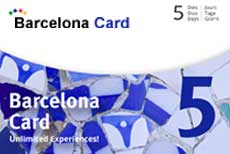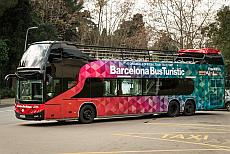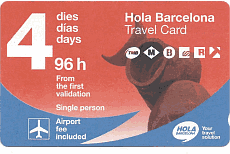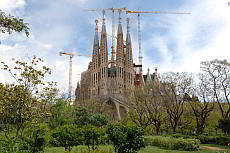Basilica Sagrada Familia
Guided Tour and admission to Antoni Gaudís most famous sight in Barcelona
The Basilica Sagrada Familia is the landmark of Barcelona. Here you can book tickets for guided tours and for the admission without standing in line. Read why the Sagrada Familia is worth visiting.
Beginning of the Construction of Sagrada Familia
Content of this page
In the middle of the 19th century, José María Bocabella, president of the Holy Brotherhood, planned to build a church in Barcelona and dedicated it to the Holy Family "Sagrada Familia". He chose a property within the street grid in the former "Poblet" (small village), in today's Eixample district.
A property closer to the city center was not possible due to the already high land prices.
Initially, the diocese architect Francisco del Villar planned the church. He designed a church in the Gothic style and the work according to these plans began in 1882 with the construction of the crypt. Due to fundamental disagreements with Bocabella, however, he had to vacate the order. A few months later, in 1883, the young architect Antoni Gaudí took his place and found his life's work in it. Until his death on June 10, 1926, he worked on the Sagrada Familia.
Under Gaudí, the church became so important because of its expansive dimension and lush design that it soon became known as "the cathedral". Even Gaudí himself called the church "the cathedral", although it didn't host a bishop's seat. Gaudí was convinced that the city would someday be known for "his" church.
Construction progress of the Sagrada Familia until completion in 2026
Gaudí influenced the Sagrada Familia significantly: all the architects who continued to work on the Basilica Sagrada Familia after Gaudí, were guided by Master's plans, models and records. For many newer parts Gaudí's models were hardly preserved and one was often dependent on assumptions, as the great master builder had probably originally intended. But this gave Antoni Gaudí's successors the opportunity to realize their own style in the Sagrada Familia.
But all are certain: because of its immensity the Sagrada Familia, once completed, will surpass all the churches previously built by Christendom.
Moreover, as a church, the Sagrada Familia may not be viewed solely from an artistic point of view. During the visit one should also consider the profound religiosity, which is reflected in the symbolism of almost every single stone of the building with its facades and towers.
On November 7th, 2010, the Sagrada Familia was consecrated by Pope Benedict XVI. and thus raised to a basilica.
The Facades of the Sagrada Familia
As different as the facades of the Sagrada Familia are, they all have one thing in common: They are full of symbolism.
The Facade of Christ's Birth (Christmas Facade)
The facade of the Nativity was completed first. It consists of three large portals - a large central gate and two smaller side gates - and four bell towers. Because of the unity with the very original towers this unity breaks with the gothic style, which can still be found in the crypt.
The three stems are dedicated to the most important dogmas of Catholicism as well as the origin, the childhood and the youth of Jesus.
The threefold facade forms a uniform landscape in which the human figures stand out. It is an allegory of the miracle of evolving, ever-changing nature, the creator of all forms of existence.
Between the three gates we can see two tall and especially elaborate pillars, crowned by palm trees and resting on two large turtles made of stone. The turtles are symbols of immutability and guarantee the continuity of the cosmos in traditional Chinese culture, which was well known in the Western world at the end of the 19th century. In contrast, the two chameleons on both sides of the Great Façade certainly represent the constant change of nature.
Structural and architectural elements form the base of the facade of birth. The many ornaments and the large number of sculptures are Especially noticable.
The left portal is called "Portal of Hope", the middle one is called "Portal of Mercy" and the right one is the "Portal of Faith". Between the portals above the columns you can see trumpet angels announcing the end of the world. Above the portals, barely discernible, the astrological zodiac spans out showing the signs. The portrayal of the zodiac, as a pagan representation that fate lies in the stars, was actually not allowed back then.
The Three Portals of the Facade of Christ's Birth
Around Gaudí's Portal of Hope on the left of the main portal, Gaudí shows scenes that do not give reason for hope. They show scenes, such as the murder of children by Herod, the flight to Egypt, a child carrying a dead dove in his hand.
The arch above the gate represents a two-man saw, tools are shown that are related to occupations in the construction industry. The portal is crowned by a rock representing Mount Montserrat.
The middle and largest portal is called Portal of Mercy. The portal is bisected by a pillar. A snake meanders around the pillar with the apple of sin in its mouth. Above you can see the nativity scene, Joseph and Mary worshiping the Christ child. As faces of the figures Gaudí used face masks of the workers who worked at the Sagrada Familia, as well as death masks of deceased. In a higher level above the portal you can see Jesus crowning Mary, which impressively demonstrates the Catalan Marian devotion.
The right portal of faith shows some scenes from the Gospels. Above the gate you can see a cruel portrayal of the Heart of Jesus, studded with thorns. Above, there are several groups of figures. They show Mary visiting her cousin, Joseph and Mary in adoration of Jesus. On the upper levels, the main contents of Catholicism are depicted: the Trinity, the dogma of the Immaculate Conception, the Eucharist and the Wisdom of God, conspicuously portrayed by a hand with one eye.
The Tree of Life
On top of the facade of birth, the three portals are crowned by the pinnacle in the shape of a cypress tree. At the Tree of Life a bridge leads between the two towers. From here you have a breathtaking view of Barcelona.
The Facade of the Ordeal
"If I had begun the construction with this facade, one would have distanced oneself from this work". Gaudí gave this statement for not having started the Sagrada Familia with the portal of suffering. This is a proof of how dramatic he wanted to impression of it to be.
Gaudí designed the portal during a serious illness in 1911. The last weeks of Jesus' life are told. The figures are reminiscent of Expressionism, an art style preferred by Gaudí. The pillars of the canopy are reminiscent of bones. Gaudí passed away before the facade and the portal were completed.
In 1988, the sculptor Josep Maria Subirachs was commissioned with the creation of the sculptures. He workedaccording to still preserved drawings by Gaudí. Subirachs began with the sculptures in 1989. On a scene with three image levels, the sculptor shows the story of the ordeal from the Last Supper to the death of Jesus. Subirachs, whose style is marked by distinctive edges, has set a sequence of representations in the form of an inverted S.
Subirach presents mysteries to the viewer, such as the magic square whose cross sum always gives 33 - the age of Jesus at his death. Other interpretations are possible.
The Facade of Bliss
The facade of bliss will be the largest and most magnificent facade of Sagrada Familia. The four towers are even higher than the other two facades. This facade is not finished yet.
On the Facade of bliss Gaudí wanted to show the last four events of one person: death, the Last Judgment, hell and bliss.
Seven entrances are to lead into the church on this side.
The Interior of the Sagrada Familia
The completion of the interior and the consecration were a great moment for Barcelona. Finally, the ground-breaking design of the brilliant Antoni Gaudí can not only be admired from the outside - and all this without scaffolds and machine noise.
The church building of the Sagrada Familia is based on the classical construction of a five-aisled basilica. The middle ship clearly towers the others, each of the five is assigned a gate to the unfinished glory facade. There are also two side portals that lead to the penitential and baptistry chapel. The altar is located behind the nave, inside the apse, in the light of the many windows.
Just as the facades are characterized by a multi-layered symbolism, the floor plan of the church is full of symbols. Every door, every pillar and almost every surface has its own specific or symbolic meaning. These allusions and parables refer to the individual Catalan and important Spanish dioceses, to every church in Latin America and to each of the five continents. Additionally, the apostles, great founders of the order and especially revered saints, the theological virtues, the sacraments and much more are referred to again and again.
The Vault and Column System inside the Basilica
The first designs of the naves resembled the Gothic in their basic features, but without the in the Middle Ages additionally used buttresses and walls. In these original sketches, the walls were still supporting elements, each column indispensable for the statics of the house. Gaudí's research into statics was groundbreaking: the architect knotted ropes together so that the resulting rope construction corresponded to the planned structure with columns and walls. He turned the construction upside down and hung small weights at the pressure points. That's how he could simulate the pressure gradients in the columns. He photographed the cable framework and turned the photo over again. Now he was able to recognize pressure and stress curves well even without static calculations.
One result of his research is the tree-like columnar structure: Gaudí's columns are inclined and branched like trees. The weight is guided directly over the pillars into the ground - all of that without load-bearing facade or outer longwall sheets. The result of this ingenious solution is spectacular: the pillars and the vaults they carry transform the interior of the temple into a stone palm forest, with an abundance of light streaming in through the large windows and through the vault.
The Architect Antoni Gaudí
Barcelona's most famous architect of the Modernism, the Catalan version of the Art Nouveau, was working on Sagrada Familia until his death.

The straight and partially inclined columns are decorated with grooves. This creates the impression that the material that makes up the columns has stretched. Above, the pillars branch so that each of them can support multiple points on the ceiling. All sections of the roof are supported by such branched columns.
Finally, the columns are made of materials of different hardness. The longest and thickest columns are made of reddish porphyry, a very hard, volcanic rock. The darker, slightly smaller columns are made of basalt, the brighter pillars of granite and the outermost row of columns in the church building of a relatively soft rock from the mountain of Barcelona, the Montjuïc. The "smallest" columns carry the choir.
The interior of the Sagrada Familia focuses on the essence of Gaudí's architecture: there is no model in architecture for the vault and column system. Only in the nature studied by Gaudí.
The Five Naves
The layout of the church has the shape of a Latin cross - with enormous dimensions. Once finished, the Sagrada Familia will be one of the largest church buildings in the world: from the entrance to the apse it is 90 meters, the five ships are bounded by a 60 meters long and 45 metres wide crossing. The four aisles are each 7.50 metres, the main ship with 15 metres exactly twice as wide. The vault is 45 metres high, while those of the aisles grow 30 metres into the air.
The construction of the ships began in 1987 according to models made by Antoni Gaudí, which were not destroyed during the Spanish Civil War.
In the outermost naves, the choirs are each located on a gallery. These offer space for over 1500 singers.
The Apse of the Sagrada Familia
An apse is a room covered by a half-dome. In a church, it is usually the area where the altar stands.
Immediately after the completion of the crypt, Gaudí had the apse built over it. Held in gothic style the apse is framed by seven chapels and two side staircases to the left and right. These continue the turning staircases leading upwards from the crypt to the facades. As an indication for the spiral staircase, two large stone slugs crawl down the wall on the outer walls of the apse. The walls inside the apse are decorated with angels' heads and tears to commemorate Jesus suffering.
Completed in 1893, the apse is crowned by a huge dome dedicated to Mary, which is supported by thick pillars. The architect succeeded creating a unit consiting of the crypt, the apse and the dome dedicated to the Marian devotion. The peak of the cult of Mary within Christianity was in the 19th century, with Gaudí especially praising the Blessed Virgin.
The entire apse and the dome are flooded with light - brighter than is already characteristic for Gothic architecture. Also dedicated to the Assumption of the Virgin is an external door of the cloister of Sagrada Familia. Justifiably and with pride, Gaudí considered his architectural style as perfecting the Gothic.
The altar is located in the middle, above you can see the Latin cross with a canopy decorated with the tendrils and grapes of a vine - the only concession Gaudí made to classical church design. Behind the altar the organ pipes rise, which have powerful dimensions, but nevertheless look very delicate.
The apse, completed in 1993, shows Gaudí's great ingenuity on its walls, stained-glass windows and lace towers. The interior is decorated with angels' heads and tears arranged in groups reminiscent of the Passion of Christ. Frogs, dragons, lizards, snakes and salamanders cling to the outer wall of the church "without being able to enter it" as they symbolize diabolical forces. But they fulfill the reasonable purpose of directing the rainwater to the outside when it rains. The battlements on the walls represent grasses.
The Towers of Sagrada Familia
On November 30, 1925, the St. Barnabas Tower was completed, the first tower on the left side of the facade of the Nativity. It was the only tower of which Gaudí still experienced the completion.
The towers are as impressive from the inside as from the outside. To go to the top you can use the stairs or a lift. In the lower part of the towers, a spiral staircase leads upwards. The staircase has barely any railings, because it is very steep. The stairwell is very small.
When you reach the top of the fourth part of the tower, you can switch from one tower to another.
In the upper part, the bells are going to be hung up once finished. Inside, there are several galleries, one above the other, from which you can follow the mass.
In the following years after Gaudí's death, his successor, the architect Sugrañes, completed the other three towers. Later, the construction of the almost identical four towers of the facade of the ordeal began. They were completet in 1977. Many years will pass until the towers of the facade of bliss are built, for they are much higher than those completed so far.
The church towers are dedicated to the twelve apostles, especially the four oldest ones, of which the outer ones are 94 and the inner ones 107 metres high. They carry the names and the corresponding sculpture of each apostle, which are sitting on a pedestal.
The Rosary Chapel, the crypt, the apse and the cloister are the areas inside the Sagrada Familia that contain the most symbols.
The Rosary Chapel
Of the two chapels planned at the corners of the cloister, Gaudí only completed the "Our Blessed Virgin of Rosary". The Rosary Chapel is a relatively small chapel, but its dome is designed to be flooded with light. It is richly decorated, so that it looks like the walls were made of bobbin lace. The presentation of the death of the righteous, which you can see underneath the arches, is especially noticable. It shows the Blessed Virgin presenting the child to a dying man.
The groups of figures that generally attract the most attention are various depictions of the temptations. The first shows a woman offered a purse of money by a vicious monster, the second a man tempted by another devil with an Orsini bomb used by the anarchists for their attacks. But both resist temptation by entrusting themselves to the protection of the Blessed Virgin.
The Crypt
The crypt of the Sagrada Familia is located between the Portal of Christ's Birth and the Sufferings of Jesus. The Greek word "crypt" means "hiding place" and is due to the first Christian tombs that were hidden underneath houses and in catacombs due to the persecution of Christians.
The architect Gaudí would have preferred to orient the facade dedicated to the Nativity, as tradition demands, to the sunrise and the Passion and death of Christ towards the sunset. But since the construction of the crypt had already begun, this was no longer possible. Gaudí, however, raised the vault and surrounded it with a ditch so that light and air could flow directly into it. The crypt of the Sagrada Familia was completed in 1891.
The crypt, like most nineteenth-century churches, is built in Neo-Gothic in style. It consists of a rotunda surrounded by seven individual chapels - the middle one is dedicated to St. Joseph. Across from it five more chapels are arranged in a straight line. In the middle of these chapels you can see the altar where the mass is read. To the left of the central chapel the Chapel of the Blessed Virgin of Montserrat, patron saint of Catalonia, and the Chapel of the Holy Christ are located, at the feet of which José María Bocabella is buried. The chapel of the Blessed Sacrament and the Blessed Virgin of Carmel, at whose feet Gaudí is buried, are located to the right.
The Cloister of the Sagrada Familia is Unusual
There is one unusual part about Sagrada Familia: the cloister. Normally the cloister of a cathedral or a monastery is on the inside. The cloister of the Sagrada Familia, however, is located on the outside of the four facades and encloses the various buildings that are part of Sagrada Familia: baptistery, sacristies and other chapels and outbuildings.
The cloister serves, as Gaudí himself said, for internal gathering and prayer, as one walks through it, or for processions when they can not be outdoors in rainy weather. Above all, he avoids that the street noise penetrates inward.
The four sides of the rectangle each correspond to a facade, but their portals interrupt the continuity of the cloister only partly, as passing through remains possible. These are the portals dedicated to the birth or the Passion of Christ, located on either side of the church at the ends of the transept, and the portal of salvation in front of the great nave. On the opposite side of the cloister you can see the rather restrained portal of the Ascension with the side entrances to the crypt.
When will the Sagrada Familia be finished?
The completion of the Sagrada Familia is scheduled for 2026, the 100th anniversary of Antoni Gaudí's death. The building is financed exclusively from donations and entrance fees. Currently 8 of the 12 over 100 metres high bell towers are completed. The higher towers of the facade of glory are still being built, as is the central dome with a height of over 170 metres. At present, parts of the cloister, the dome and the apse are also being built.
In 2017, the construction of the Towers of the Evangelists and the Virgin Mary began. The towers follow the architectural model of the sacristy, of which one of Gaudí's plaster models is still preserved.
Tower of the Virgin Mary
This tower is located above the apse and surrounds the large hyperboloid that surrounds the altar and brings light into the interior of the church. The inside of the tower will be a monumental empty space.
At the end of 2017, 5 levels of the tower were completed and the tower now reaches a height of 85 metres. Blue granite reminds of the Virgin Mary's coat. At the base of the tower, in addition to the text of the Ave Maria several reliefs of flowers are attached, which are associated with Mary. These were designed under the supervision of Etsuro Sotoo.
Towers of the Evangelists and Tower of Jesus
The towers of Matthew, John, Mark and Luke are already about 85 metres high. In 2022 they will be completed with a height of 135 metres.
The tower of Jesus Christ will be the highest tower at 172.50 metres. Inside, a spiral staircase and a glazed lift will lead upwards in a room of 60 metres hight.
Tickets and tours in the Sagrada Familia here
(Click on the product images to view prices and availability)
Important information
Surroundings
Find Hotels nearby
Address
Mallorca, 401
Arrival
Metro: Sagrada Familia (L2, L5)
Bus Turístic: Sagrada Familia
Parking nearby
Opening times
Nov.-Feb.: 9:00-18:00, Sun. 10:30-18:00
March and Oct.: 9:00-19:00, Sat. 09:00-18:00, Sun. 10:30-19:00
April-Sep.: 9:00-20:00
On 25.12./26.12./1.1. and 6.1. 9:00-14:00.
Tips for visiting the Sagrada Familia
Tickets can only be purchased online. Please book early, as availability is limited.
The church is full of details, with many hidden messages and biblical stories. Allow 2-3 hours for a guided tour and sightseeing.
A nice introduction is also our exciting Façade Tour (booking see above), on request with ticket for the entrance and the towers.
What should be considered when entering the church?
We recommend wearing appropriate clothing. Shoulders and legs should be covered (eg the skirt or pants should be longer than half of the thigh). Backless or cropped tops, for example, are not appropriate. Of course, you should not want to enter the church wearing swimwear. Headgear like hats or caps are not allowed. Exceptions are religious or health reasons. The church may not be entered barefoot. The entrance is not permitted with garments reminiscent of "celebrations" or with ornaments that distract or attract attention for artistic, religious, promotional or other purposes.
Book your accommodation in Barcelona here! All categories.
1-5*-hotel rooms, apartments, hostels.




